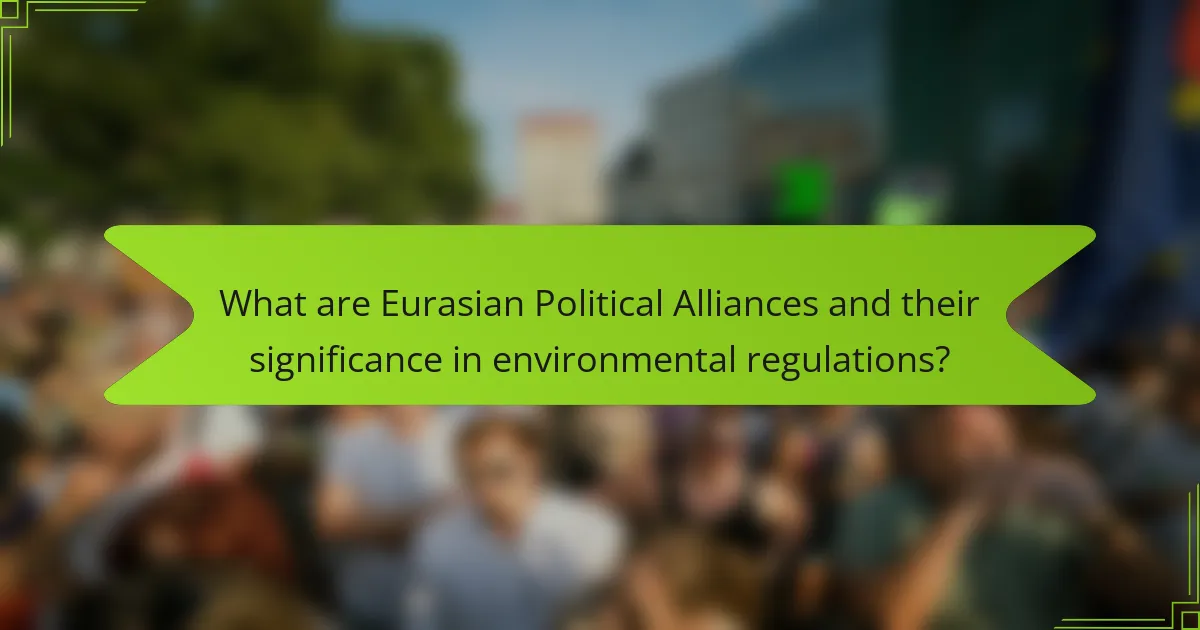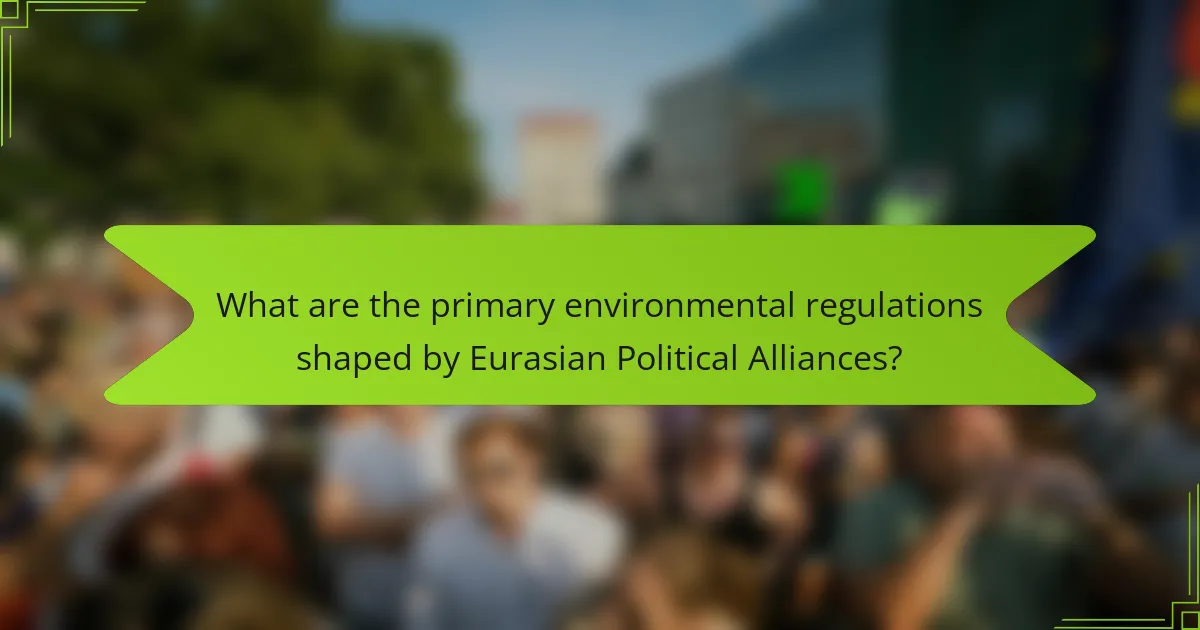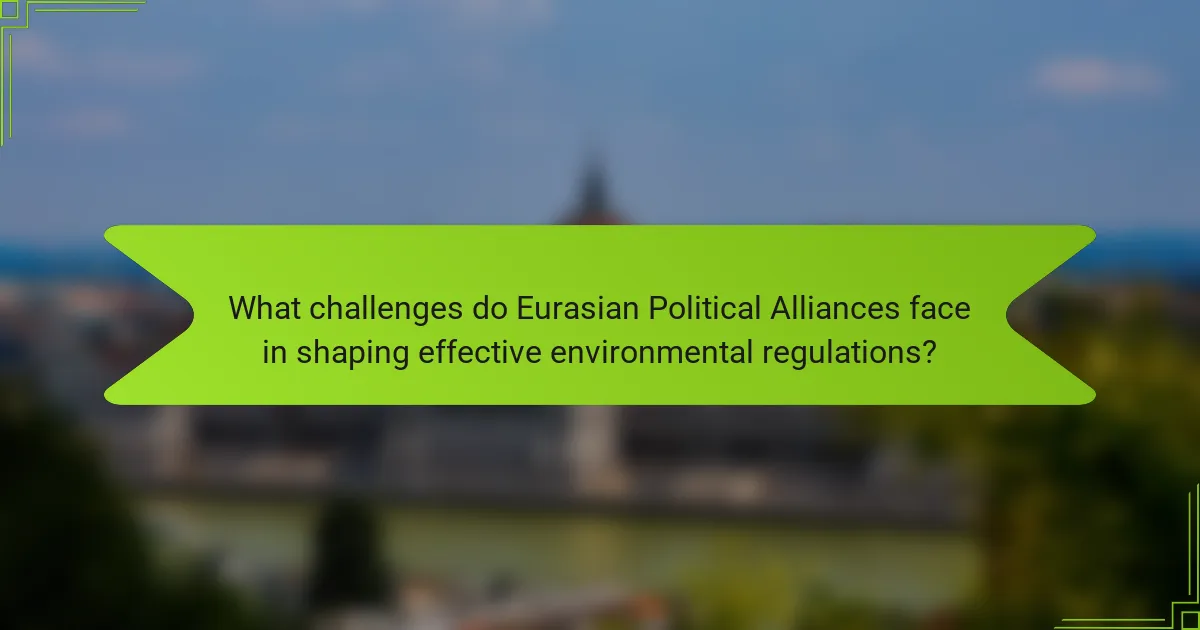Eurasian political alliances, such as the Eurasian Economic Union (EAEU) and the Shanghai Cooperation Organization (SCO), are cooperative agreements between countries in the Eurasian region aimed at mutual support and collaboration, particularly in shaping environmental regulations. These alliances facilitate dialogue on environmental policies, promote sustainable development, and address regional challenges like climate change and biodiversity loss. They enhance the capacity of member states to implement effective environmental regulations through shared best practices and resources. However, these alliances face challenges, including differing national interests, policy fragmentation, and external geopolitical pressures, which complicate unified environmental governance in the region.

What are Eurasian Political Alliances and their significance in environmental regulations?
Eurasian political alliances are cooperative agreements between countries in the Eurasian region aimed at mutual support and collaboration. These alliances, such as the Eurasian Economic Union (EAEU) and the Shanghai Cooperation Organization (SCO), play a significant role in shaping environmental regulations. They facilitate dialogue and coordination on environmental policies among member states.
For instance, the EAEU promotes sustainable development through joint environmental initiatives. The SCO addresses regional environmental challenges, including climate change and biodiversity loss. These alliances enhance the capacity of member states to implement effective environmental regulations. Collaborative efforts lead to the sharing of best practices and resources for environmental protection.
Research shows that such alliances can lead to more comprehensive and cohesive environmental policies across borders. This is essential for addressing transboundary environmental issues effectively. The significance of these alliances lies in their ability to unify efforts for sustainable environmental governance in the region.
How do Eurasian Political Alliances influence environmental policy-making?
Eurasian political alliances influence environmental policy-making through collaborative agreements and shared regulatory frameworks. These alliances, such as the Eurasian Economic Union, promote joint environmental standards among member states. They facilitate the exchange of best practices and technologies for sustainable development. Additionally, political alliances can leverage collective bargaining power on international environmental issues. This coordination often results in more robust environmental policies that address regional challenges. For example, joint initiatives on air and water quality have emerged from these alliances. The alignment of member states’ policies leads to more effective implementation of environmental regulations. Overall, Eurasian political alliances play a crucial role in shaping cohesive environmental strategies across the region.
What are the key characteristics of these alliances?
Key characteristics of Eurasian political alliances include collaboration among member states, shared political goals, and mutual economic interests. These alliances often focus on environmental regulations to address common challenges. They facilitate dialogue and cooperation on sustainable practices. Member states typically engage in joint initiatives to enhance environmental protection. Additionally, these alliances may establish regulatory frameworks to standardize environmental policies. They often leverage collective bargaining power in international negotiations. The alliances also encourage knowledge sharing and capacity building among members. Finally, they help to align national policies with regional environmental objectives.
How do member states collaborate on environmental issues?
Member states collaborate on environmental issues through treaties and agreements. These frameworks facilitate joint action on climate change, biodiversity, and pollution control. For example, the Paris Agreement binds countries to limit global warming. Regular meetings, such as the Conference of the Parties, allow states to assess progress and set new targets. Additionally, regional organizations promote collaboration by sharing best practices and resources. Data exchange enhances transparency and accountability among member states. Collaborative projects often focus on sustainable development goals. This cooperation is essential for addressing transboundary environmental challenges effectively.
What are the historical contexts of these alliances in shaping environmental regulations?
Eurasian political alliances have historically influenced environmental regulations through collaborative agreements and shared policies. The formation of alliances like the Shanghai Cooperation Organization in 2001 aimed to enhance regional cooperation, including environmental issues. These alliances emerged in response to transboundary pollution and the need for collective action against environmental degradation. The 1992 Earth Summit in Rio de Janeiro marked a significant moment, as it prompted countries to engage in international environmental treaties. Subsequent treaties, such as the Kyoto Protocol, saw participation from various Eurasian states, shaping their environmental commitments. Historical tensions, such as those from the Cold War, also influenced the willingness of states to cooperate on environmental matters. The need for sustainable development has led to joint initiatives addressing climate change and biodiversity conservation. These historical contexts underscore the importance of political alliances in formulating and implementing effective environmental regulations across Eurasia.
What major events have influenced the formation of these alliances?
The major events that have influenced the formation of Eurasian political alliances include the dissolution of the Soviet Union in 1991. This event led to the emergence of new independent states seeking collaboration for economic stability. The 2008 financial crisis prompted countries to strengthen alliances for mutual support. Additionally, climate change discussions have driven nations to form alliances focused on environmental regulations. The Paris Agreement in 2015 further catalyzed cooperative efforts among these countries. Regional conflicts, such as those in Ukraine and Syria, have also shaped alliances as countries align based on security interests. These events collectively highlight the dynamic nature of political alliances in Eurasia.
How have past environmental crises impacted alliance strategies?
Past environmental crises have significantly influenced alliance strategies among nations. For instance, the 1986 Chernobyl disaster prompted Eastern European countries to reconsider their nuclear policies, leading to stronger regional cooperation on energy safety. The 2004 Indian Ocean tsunami resulted in enhanced collaboration among Southeast Asian nations for disaster preparedness and response. These events highlighted the necessity for collective action in addressing environmental challenges. As a result, countries formed alliances to share resources and knowledge. The Paris Agreement in 2015 exemplifies how past crises have driven nations to unite for climate action. Historical data indicates that environmental threats often catalyze diplomatic efforts and policy alignment among nations.

What are the primary environmental regulations shaped by Eurasian Political Alliances?
Eurasian Political Alliances primarily shape environmental regulations through agreements on pollution control, biodiversity conservation, and climate change mitigation. These regulations are often established within frameworks like the Eurasian Economic Union (EAEU) and the Shanghai Cooperation Organization (SCO). The EAEU promotes harmonized standards for environmental protection among member states. The SCO facilitates cooperation on ecological sustainability and disaster management. Additionally, regional agreements often address transboundary environmental issues, enhancing collaborative efforts. These regulations reflect a commitment to sustainable development in Eurasia.
How do these regulations address climate change and sustainability?
These regulations address climate change and sustainability by establishing binding commitments to reduce greenhouse gas emissions. They promote renewable energy sources and energy efficiency measures. Specific targets are set for emissions reductions, often aligned with international agreements like the Paris Accord.
Additionally, they encourage sustainable land use practices and conservation efforts. These regulations often include incentives for businesses to adopt greener technologies. They may also impose penalties for non-compliance, ensuring accountability.
Furthermore, collaboration among member states enhances resource sharing and best practices in environmental management. This collective approach strengthens regional capacity to combat climate change effectively.
What specific policies have been implemented as a result of these alliances?
Specific policies implemented as a result of Eurasian political alliances include the establishment of transnational environmental standards. These standards aim to harmonize regulations across member states. For instance, the Eurasian Economic Union adopted a common environmental framework in 2015. This framework includes guidelines for waste management and pollution control. Additionally, collaborative initiatives have been launched to address climate change impacts. These initiatives promote sustainable resource management and conservation efforts. Evidence of these policies can be seen in joint projects funded by member states to improve environmental monitoring. Overall, these alliances have led to significant progress in regional environmental governance.
How do these policies compare across different member states?
Policies across different member states in Eurasian political alliances vary significantly in their environmental regulations. Some member states adopt stringent regulations emphasizing sustainability and conservation. Others implement more lenient policies prioritizing economic growth over environmental protection. For instance, countries like Kazakhstan have invested heavily in renewable energy initiatives. In contrast, states such as Belarus focus on industrial development without stringent environmental oversight. The differences often stem from varying economic priorities, political structures, and levels of public environmental awareness. These disparities impact regional cooperation on environmental issues and the effectiveness of collective agreements.
What role do international agreements play in these alliances’ environmental strategies?
International agreements are crucial in shaping the environmental strategies of Eurasian political alliances. They provide a framework for cooperation among member states. These agreements facilitate the sharing of best practices and technologies. They also set binding commitments for reducing emissions and protecting natural resources. For example, the Paris Agreement influences national policies on climate change. This agreement encourages countries to set and achieve emission reduction targets. Additionally, international agreements often include financial mechanisms to support environmental initiatives. These mechanisms help countries implement sustainable practices and technologies. Overall, international agreements enhance collaboration and accountability among alliance members in their environmental efforts.
Which international treaties are most relevant to Eurasian Political Alliances?
The most relevant international treaties to Eurasian Political Alliances include the Treaty on the Non-Proliferation of Nuclear Weapons (NPT) and the Paris Agreement. The NPT aims to prevent the spread of nuclear weapons and promote peaceful uses of nuclear energy. It establishes a framework for cooperation among member states, including many in Eurasia. The Paris Agreement focuses on climate change and requires countries to set emission reduction targets. This treaty encourages collaboration among Eurasian nations to address environmental challenges. Both treaties significantly influence political alliances by fostering cooperation on security and environmental issues.
How do these treaties influence local regulations within member states?
Treaties influence local regulations within member states by setting binding commitments that require compliance with international standards. These agreements often establish frameworks for environmental protection that member states must integrate into their national laws. For instance, treaties may mandate specific emissions reductions or conservation practices. This creates a legal obligation for countries to align their regulations with treaty provisions. Additionally, treaties can facilitate cooperation among member states, promoting shared best practices. The European Union’s environmental directives serve as a prime example, as they shape national legislation across member countries to meet collective goals. Consequently, local regulations are often revised to ensure compliance with treaty obligations, reflecting a harmonization of environmental standards across borders.

What challenges do Eurasian Political Alliances face in shaping effective environmental regulations?
Eurasian political alliances face significant challenges in shaping effective environmental regulations. These challenges include differing national interests among member states. Countries may prioritize economic growth over environmental protection. Additionally, there is often a lack of cohesive policy frameworks. This fragmentation complicates the implementation of unified environmental standards. Political instability in some regions further hampers collaborative efforts. Resource constraints also limit the capacity for effective regulation enforcement. Moreover, varying levels of public awareness and engagement affect policy support. Lastly, external geopolitical pressures can undermine collective environmental initiatives.
How do political differences among member states affect environmental collaboration?
Political differences among member states significantly hinder environmental collaboration. Divergent national interests can lead to conflicting priorities in environmental policies. For instance, countries with strong economic ties to fossil fuels may resist commitments to reduce carbon emissions. This creates a lack of consensus on international agreements. Disagreements can also arise over funding for environmental initiatives. Member states may prioritize domestic issues over collective environmental goals. Historical examples include the varied responses to the Paris Agreement. Some countries pledged ambitious targets while others sought exemptions. These disparities can stall negotiations and weaken collective action. Ultimately, political differences create barriers that complicate unified environmental efforts.
What are the implications of economic disparities on environmental policies?
Economic disparities significantly influence environmental policies. Wealthier nations often prioritize environmental regulations due to available resources. In contrast, economically disadvantaged countries may lack funding for sustainable practices. This leads to a disparity in environmental enforcement and compliance. For example, the Global Environmental Facility reports that low-income countries receive less than 10% of global environmental funding. Furthermore, economic interests can overshadow environmental concerns, resulting in lax regulations in poorer regions. This creates a cycle where economic growth is prioritized over environmental sustainability. Ultimately, economic disparities lead to uneven environmental protections and varying policy effectiveness across regions.
How do external pressures from global environmental movements impact these alliances?
External pressures from global environmental movements significantly influence Eurasian political alliances. These pressures often lead to increased collaboration among member states to address environmental concerns. For instance, the Paris Agreement has prompted alliances to adopt more stringent climate policies. Additionally, public advocacy from environmental organizations can shift political priorities within these alliances. Countries may face reputational risks if they do not align with global environmental standards. This dynamic encourages member states to enhance regulatory frameworks and share best practices. Ultimately, external pressures drive collective action towards sustainable development within these alliances.
What are the future prospects for Eurasian Political Alliances in environmental governance?
The future prospects for Eurasian Political Alliances in environmental governance are promising yet complex. These alliances can enhance regional cooperation on environmental issues. Increased collaboration may lead to unified strategies for climate change mitigation. Economic integration within Eurasia supports shared environmental goals. Initiatives like the Eurasian Economic Union promote sustainable practices. However, political tensions may hinder effective governance. Diverging national interests can complicate consensus-building. Overall, the potential for impactful environmental governance exists, contingent on overcoming geopolitical challenges.
What emerging trends could reshape their approach to environmental regulations?
Emerging trends that could reshape the approach to environmental regulations include increased collaboration among Eurasian political alliances. These alliances are focusing on shared environmental goals. A significant trend is the rise of green technology initiatives. Countries are investing in sustainable energy solutions. This investment is driven by the need to reduce carbon emissions. Additionally, there is a growing emphasis on biodiversity conservation. Political alliances are creating frameworks for cross-border environmental protection. The adoption of stricter compliance measures is also on the rise. These measures are aimed at holding industries accountable for environmental impacts. Furthermore, public awareness and activism are influencing policy changes. Citizens are demanding more transparency and action from governments.
How can these alliances improve their effectiveness in addressing environmental issues?
Eurasian political alliances can improve their effectiveness in addressing environmental issues by enhancing collaboration among member states. Increased collaboration allows for shared resources and expertise. Joint initiatives can lead to more comprehensive environmental policies. Establishing common goals can unify efforts against climate change. Regular communication can facilitate the exchange of best practices. Leveraging regional data can inform better decision-making. Engaging with local communities can ensure policies are relevant and effective. These strategies can lead to more impactful environmental outcomes across the region.
What best practices can be adopted by Eurasian Political Alliances for better environmental regulation?
Eurasian Political Alliances can adopt several best practices for better environmental regulation. First, they should establish a unified regulatory framework that promotes cooperation among member states. This framework can enhance compliance and enforcement of environmental laws. Second, they can implement joint environmental monitoring systems. These systems will provide data transparency and facilitate informed decision-making. Third, promoting sustainable development initiatives can align economic growth with environmental protection. This approach supports long-term ecological balance. Fourth, fostering public-private partnerships can leverage resources and expertise for environmental projects. This collaboration can lead to innovative solutions. Additionally, engaging local communities in environmental governance can ensure that regulations are socially accepted and effective. This involvement can enhance stakeholder buy-in. Lastly, sharing best practices and success stories among member states can inspire effective environmental policies. This knowledge exchange can accelerate progress towards sustainability goals.
Eurasian political alliances, including the Eurasian Economic Union (EAEU) and the Shanghai Cooperation Organization (SCO), play a critical role in shaping environmental regulations across the region. These alliances facilitate collaboration among member states on environmental policies, addressing challenges such as climate change and biodiversity loss through joint initiatives and shared regulatory frameworks. The article explores the historical context, key characteristics, and specific policies implemented by these alliances, as well as the challenges they face in achieving effective environmental governance. It also examines the influence of international agreements and economic disparities on local regulations and future prospects for enhanced cooperation in environmental management.